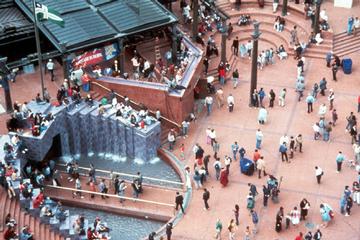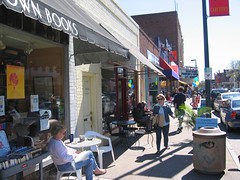The Reeves Center Myth re-revisited
In honor of the City Paper article, "14th and Blue," about the Reeves Center I am reprinting this entry from January 2006, in response to this section of the City Paper article:
When Barry’s administration pushed to construct the building in the 1980s, the goal was to help spur the redevelopment of U Street, which had been devastated in riots in 1968, then left mostly ignored for more than a decade. The Reeves Center, and the opening of Metro’s Green Line, helped do the trick. The neighborhood is booming, with condos, fancy bars and restaurants, and boutique shops galore. Now, 25 years after it opened, the District’s own parcel of real estate feels like it’s been left behind.
(Although one could argue that the Reeves Center was a key element in the revitalization process of that area, if you look at it as a process over many years--decades.
It's worth reprinting because City Council Chairman and Mayoral candidate Linda Cropp was at a community meeting recently where she talked about the Reeves Center as a perfect example of city-initiated and city-sparked development. This has been bugging me since I read it, but I didn't get around to writing about it. See this article "In Ward 8, Anger Over Stadium Deal," and this quote (of course Councilmember Barry was in the audience, so she must have felt obligated):
"Our visionary mayor, Marion Barry, put the Reeves [Municipal] Center up on 14th and U streets because it acted as an incentive to bring about economic development that changed the area," Cropp said.
From August 2005 but expanded slightly:
Re-reading the Post article ("Williams Proposes Moving Metro Offices to Anacostia") it quotes Mayor Williams as saying he was inspired to suggest this development at the Anacostia Metro Station by the actions of Mayor Barry's building of the Reeves Center.

The Reeves Center is pretty typical of the urban brutalist DC urban renewal projects from the mid-1970s onwards.
IT IS A MYTH that the Reeves Center sparked the revitalization of U Street. It is an urban brutalist monster that sucks the life off of the street. Many of the retail businesses in the Reeves Center have failed--most leaving lease debts in the hundreds of thousands of dollars--debts that the District government had to eat.
------------
Note: the building is just bulky, it's not really an example of urban brutalist design.
------------
The other three corners of the intersection have fast food places or a vacancy. AND, it took more than 10 years after the Reeves Center before "revitalization" started happening--much of it being sparked by the opening of the Green line subway stations. (Granted, the construction of the Metro on U Street contributed to the problems.)
And still, the area around Reeves Center is a vacuum. What life around it has it engendered?
Why is learning from Jane Jacobs and other practitioners of urban vitality so difficult?


People on the street in Carytown, Richmond. Photo by Steve Pinkus.
Labels: intra-city sprawl, urban design/placemaking, urban revitalization



0 Comments:
Post a Comment
<< Home